Education
The best and brightest young scientists are looking beyond the U.S. as cuts hit home

Jack Castelli had it all figured out.
The University of Washington doctoral student had spent the past three years developing new gene-editing techniques that could spur immunity to the virus that causes AIDS. Early testing in mice showed promising results. His research group hoped it could develop into a treatment, or even a cure, for HIV.
Castelli, who is Canadian, saw two career paths after his graduation this spring: He could join a U.S. biotech company, or he could find a postdoctoral position at a U.S. university or research laboratory.
“This is where the money is at and where all the clinical trials are happening,” Castelli said, making the U.S. “the only place in my mind I could push that forward.”
Then the Trump administration’s science cuts hit.
And so, on a rainy late April day in Seattle, Castelli stood at a lectern before his friends and family and defended his doctoral thesis — about using stem cells to express antibodies against HIV — with his scientific life at a crossroads.
Should he join a lab in his native Canada? Accept recruiting calls to a European university? A Chinese biotech company? They were all possibilities now, and his U.S. visa is likely to expire in a few months’ time.
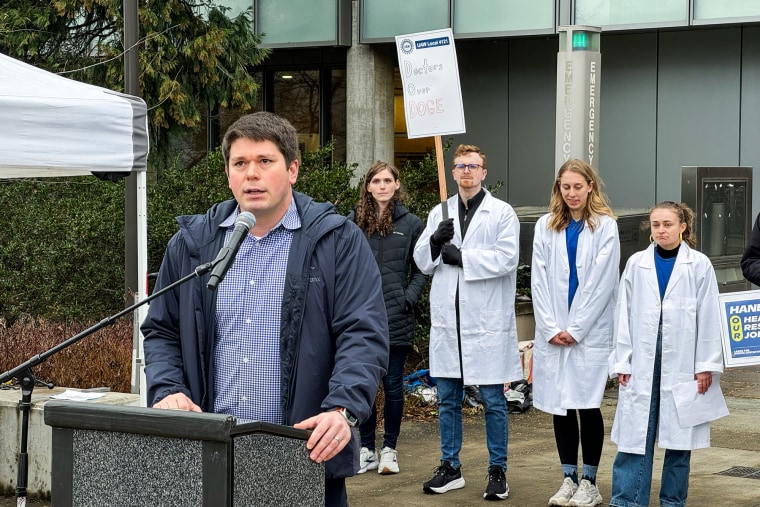
“I have a personal interest in Jack getting the best opportunity for himself, and as much as I’d love to say the U.S. is the place, I can’t necessarily say that right now,” said Jennifer Adair, who was Castelli’s principal investigator at the Fred Hutch Cancer Center, a partner institute to the university.Castelli speaks three languages fluently and completed two internships while earning his doctoral degree. He is a generous colleague and an exceptional scientist, Adair said.
But his uncertain future is hardly unique. The Trump administration’s slowdown in science funding — which stalled thousands of grants at the National Institutes of Health and National Science Foundation, among other organizations — has left U.S.-based scientists and researchers scrambling to find homes for promising work that could lead to medical treatments and cures. Now many are looking abroad. As of May, Castelli had not made a decision on whether he’ll stay in the U.S.
The slowdown has forced the University of Washington, a top public university for biomedical research, to implement a hiring freeze, travel restrictions, class size reductions and furloughs. Some departments are pushing students to graduate sooner than expected. In a court filing, a university representative said it funds about 3,000 researchers through NIH grants.
Interviews with more than 20 graduate students, faculty members and university administrators at UW describe a research hub thrown into chaos. Other institutions have made similarly drastic moves, according to court filings in lawsuits that aim to thwart the cuts.
Many of those interviewed said a generation of scientists — and the innovations their research would bring — could be decimated.
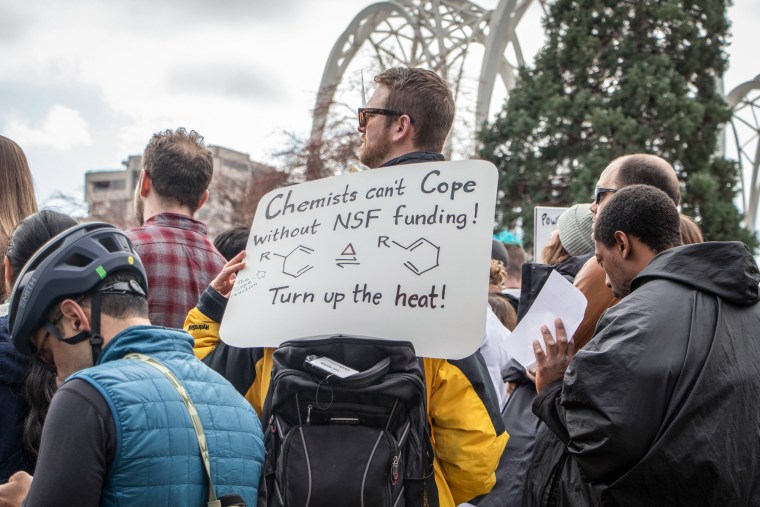
“Really talented people are not able to get jobs; other really talented people are able to get jobs, but they’re choosing not to take them because of the craziness,” said David Baker, a professor of biochemistry at the University of Washington School of Medicine, who won the Nobel Prize in 2024 for protein research. “Why would you stay in a country where there’s not really an obvious commitment to science, when you could go somewhere else and be better funded and not worry about what you can read in the news or what email you’re going to get?”In an April 14 court filing, the university’s vice provost for research, Mari Ostendorf, said the campus mood had dimmed.
“Faculty and staff don’t know if their funding will be cut, if their research will be terminated, whether they will be able to attend conferences, or even whether they will continue to have jobs,” Ostendorf wrote. “Funding gaps have forced researchers to abandon studies, miss deadlines, or lose key personnel.”
A spokesperson for the National Institutes of Health declined to comment.
And there may be even more funding lost in the future due to Trump administration decisions. After a protest at the University of Washington campus Monday over the war in the Gaza Strip, the Department of Health and Human Services, which oversees NIH, announced that it was part of a task force reviewing UW’s response to the demonstration.
About 30 people were arrested after occupying a campus building Monday, according to the university, which condemned the protest in a statement and described it as “dangerous” and “violent.”
The Trump administration previously canceled federal grants at Columbia University during a similar review and has said Harvard University will receive no new grants until it makes a series of reforms, including changes to policies about protests and antisemitism.
Although the review was only announced Tuesday, the administration’s Task Force to Combat Anti-Semitism said in a news release that “the university must do more to deter future violence and guarantee that Jewish students have a safe and productive learning environment,” adding that it expected UW “to follow up with enforcement actions and policy changes.”
A university science laboratory operates like a small factory where workers are churning out ideas, research and data, rather than furniture or light bulbs. Traditionally, these labs’ primary customers are federal science agencies, like NIH or NSF.
Think of a lab’s principal investigator as akin to a company president. In the grant process, they must convince the government or private funders to buy their product — unique research — and then pay graduate students in wages and tuition.
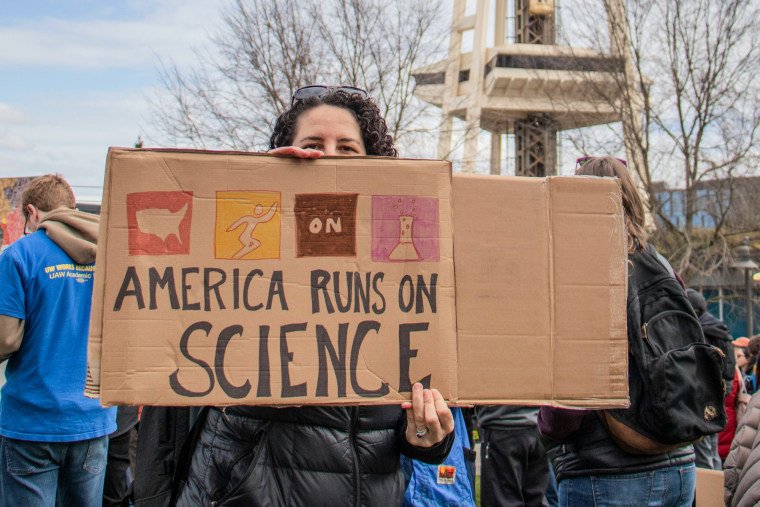
“I’m like a small-business owner,” said Adair, who recently left Seattle to serve as a professor and associate director at the UMass Chan Medical School’s gene therapy center. “I have to pay myself. I have to pay my staff. I have to find the money to do the research.”In the first few months of 2025, funding for NIH grants has lagged the year prior by at least $2.3 billion, according to STAT News. NIH has also canceled grant applications as it targets politically disfavored topics like infectious diseases, according to critics.
That funding slowdown has forced many principal investigators to reduce their lab’s size.
“We’ve had to make personnel cuts,” said Alex Greninger, a professor of laboratory medicine at UW Medicine, adding that he had been forced to rescind a job offer to a postdoctoral researcher from China who had been doing research in his lab for nearly three years.
It cost the researcher her visa, he said. Another member of his lab left to take a job at a Chinese gene synthesis firm. Several have seen placements rescinded at other institutions.
“This is the first year where people didn’t get into graduate school,” Greninger said, about technicians in his lab who have completed undergraduate degrees, adding that they had done “everything right.”
Dr. Anna Wald, the head of allergy and infectious diseases at UW Medicine, the university’s school of medicine and hospital system, said several principal investigators in her department cut part of their own salaries to keep their staffers on.
Meanwhile, Adair paid out of her own pocket to send students to conferences that could advance their careers.
The uncertainty has also simply wasted time, some said.
“Everybody is spending a lot of time dealing with changes in how the university operates,” said Jakob Von Moltke, an associate professor of immunology at the University of Washington. “Everything just functions less efficiently and there’s less innovation.”
With so many professors uncertain about funding, many first-year graduate students seeking a lab are struggling to find positions. At some UW departments, first-year graduate students often rotate between labs for several months before they select a home for the following four or five years.
“A lot of people are scrambling to find a lab to settle into and a lot of faculty are unable to commit to taking students, or backing out of commitments,” said Dustin Mullaney, a first-year doctoral student studying molecular and cellular biology.
Still, many first-years consider themselves lucky — at least they got in. Most UW departments have reduced upcoming graduate classes by 25%-50%, according to court filings in a case filed by 16 state attorneys general aiming to restore the flow of NIH funding.
“I think we are going to lose most of a generation of scientists,” said Henry Mangapalli, a first-year doctoral student in the laboratory medicine department.
Meanwhile, doctoral students nearing graduation say they’re being recruited to move abroad.
Kristin Weinstein, a fourth-year doctoral student in the department of immunology working on autoimmune research, planned to graduate next year, find a postdoctoral research position at a U.S. university and eventually become a professor.
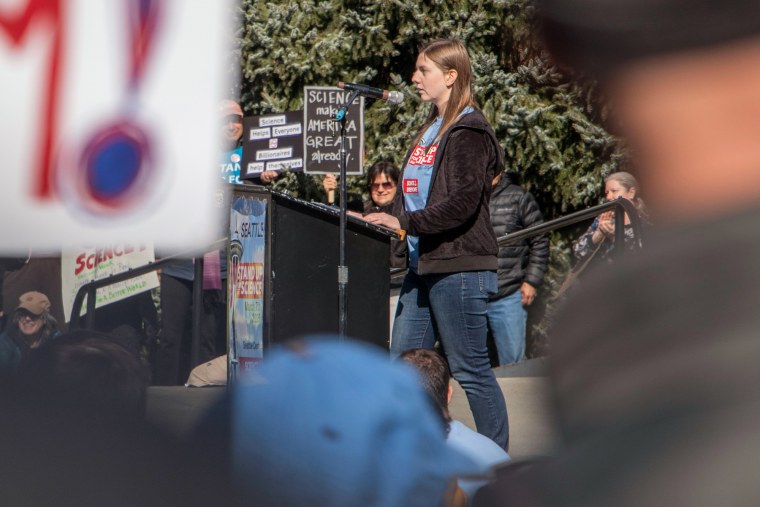
But now, faced with hiring freezes and shrinking labs, Weinstein said she’s considering moving her family, including an infant son, out of the U.S. Before UW’s austerity actions, Weinstein booked travel to Switzerland so she could present her research at the World Immune Regulation Meeting 2025, a key conference in her field.“What it turned into was a lot of informational interviewing,” Weinstein said. “I talked to faculty who are in Australia, faculty who are in Germany, faculty who are in Luxembourg and Denmark. … There was active recruiting happening.”
Baker, the Nobel winner who directs the Institute for Protein Design, said that more than 15 of his graduate students and postdoctoral researchers were aiming for new roles overseas. Meanwhile, other students have seen their research upended.
Nelson Niu, a fourth-year doctoral student in mathematics, said he had planned to spend six years teaching students and completing his thesis, a timeline sanctioned by his department. But on March 11 he received an email from his department chair saying the policy had changed for fourth-year students because of new financial realities, and people like Niu were now only guaranteed five years of funding.
“Jarring,” Niu said of the notice; now he’d have to pack two years of study into one.
Arjun Kumar, a third-year doctoral student studying why T cells lose their ability to fight off tumors, was working with National Cancer Institute researchers to potentially apply some of his research findings to a type of treatment pioneered there.
But Kumar said he lost weeks of time after the NIH placed a temporary communications freeze on federal researchers this winter.
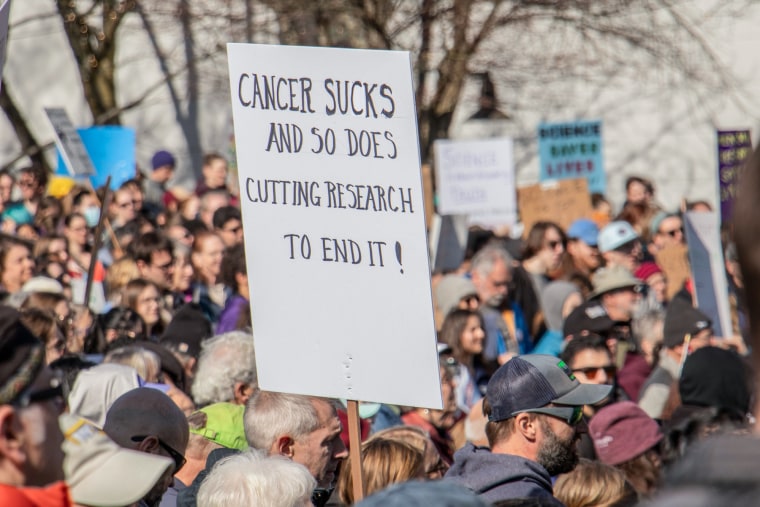
“They were already working on key experiments for us and they already had data they couldn’t send us because they couldn’t email us,” Kumar said.Later, Kumar learned the NCI researchers no longer had the bandwidth to help.
“It was an exciting collaboration that was snuffed out in the moment,” Kumar said.
Washington is one of 16 states suing the NIH and HHS over its slowdown in grant funding. A judge will hear arguments Thursday as the state attorneys general seek a preliminary injunction.
Meanwhile, the pressure on scientists to leave the U.S. is only increasing. On Monday, the European Union launched a drive to attract scientists to Europe, and European Commission President Ursula von der Leyen announced a commitment of $566 million to attract U.S. talent and “make Europe a magnet for researchers.”
“It has been really challenging to my identity as an American citizen to think about having to leave the country to pursue my career,” Weinstein said. “It feels like the American dream is dead.”
Education
Supreme Court deadlocks 4-4 on nation’s first religious charter school

WASHINGTON — Oklahoma will not be able to launch the nation’s first religious public charter school after the Supreme Court on Thursday deadlocked 4-4 in a major case on the separation of church and state.
The decision by the evenly divided court means that a ruling by the Oklahoma Supreme Court that said the proposal to launch St. Isidore of Seville Catholic Virtual School violates both the federal Constitution and state law remains in place.
As there was no majority, the court did not issue a written decision, and the case sets no nationwide precedent on the contentious legal question of whether religious schools must be able to participate in taxpayer-funded state charter school programs.
A key factor in the outcome was that conservative Justice Amy Coney Barrett, who would have been the deciding vote, did not participate in the case. She did not explain why, but it is likely because of her ties with Notre Dame Law School. The law school’s religious liberty clinic represents the school.

The one-page decision did not say how each justice voted. During oral arguments last month, most of the court’s conservatives indicated support for the school while liberals expressed concern. At least one conservative is likely to have sided with the liberals, most likely Chief Justice John Roberts.
The court will likely be asked to weigh in on the issue in future cases.
St. Isidore would have operated online statewide with a remit to promote the Catholic faith.
The case highlights tensions within the Constitution’s First Amendment; one provision, the Establishment Clause, prohibits state endorsement of religion or preference for one religion over another, while another, the Free Exercise Clause, bars religious discrimination.
The Oklahoma Supreme Court had cited the state’s interest in steering clear of Establishment Clause violations as a reason not to allow the proposal submitted by the Roman Catholic Archdiocese of Oklahoma City and the Diocese of Tulsa to move forward.
A state board approved the proposal for St. Isidore in June 2023 despite concerns about its religious nature, prompting Oklahoma Attorney General Gentner Drummond to file suit.
The case saw Drummond on the opposite side of fellow Republicans in the state who backed the idea, but he prevailed at the Oklahoma Supreme Court the following year.
The Supreme Court, when Barrett is participating, has a 6-3 conservative majority that often backs religious rights. In recent years it has repeatedly strengthened the Free Exercise Clause in cases brought by conservative religious liberty activists, sometimes at the expense of the Establishment Clause. Some conservatives have long complained that the common understanding that the Establishment Clause requires strict separation of church and state is incorrect.
Lawyers representing the school and the Oklahoma Statewide Charter School Board sought to portray the dispute as similar to a series of recent rulings in which the court said that under the Free Exercise Clause, states cannot bar religious groups from government programs that are open to everyone else.
During the oral argument, Roberts pushed back, indicating that he saw the schools case as different from the previous decisions.
Those cases, he said, “involved fairly discrete state involvement” compared with Oklahoma’s charter school program.
“This does strike me as a much more comprehensive involvement,” he added.
The push for religious public charter schools dovetails with the school choice movement, which supports parents using taxpayer funds to send their children to private school. Public school advocates see both efforts as broad assaults on traditional public schools.
Education
As colleges halt affinity graduations, students of color plan their own cultural celebrations
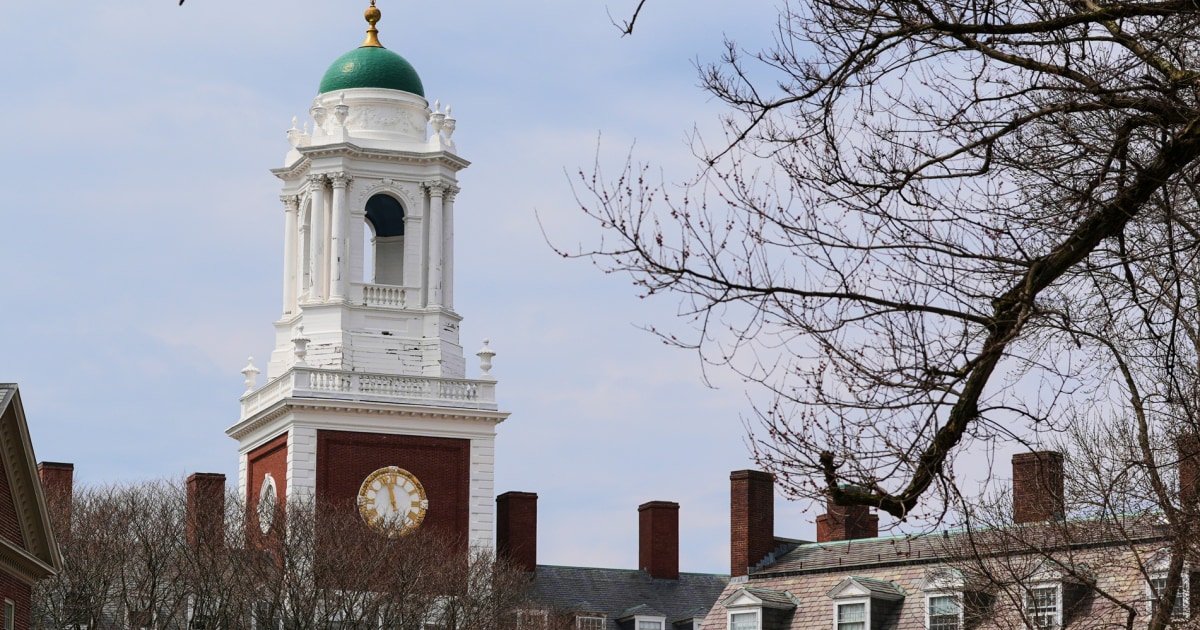
Graduating students of color at Harvard University and other colleges across the country would end their semester by attending affinity graduation ceremonies — but this year, they had to organize these celebrations without the school’s financial backing.
Harvard, currently battling the Trump administration over a range of issues, halted all of its affinity ceremonies for students this year. This left alumni stepping in to raise funds and students scrambling to find new spaces.
Members of the Harvard Black Alumni Society raised $46,000 for this year’s event after the university announced April 28 that it would no longer fund the ceremonies.
“This rapid response from our alumni network demonstrates the strength and commitment of our community,” Alana Brown, the society’s university relations chair, said in a statement earlier this week.
An attendee of Harvard’s canceled Lavender Graduation, which celebrates LGBTQ students, said on Facebook that a small group of students had organized an independent event.
“It was a beautiful mix of #lgtbqia young people and elders,” the attendee, Peter Khan, added. “It was an honor and privilege to be there.”
Harvard’s Asian American Alumni Alliance said on Facebook that its ceremony was important for students to experience because they provide space for recognition, solidarity, and community in the face of uncertainty. The alliance said the ceremony took place as the Trump administration announced plans to revoke student visas for international students at the university.
These actions come as the Trump administration this week asked federal agencies to potentially end their contracts with the university, worth an estimated $100 million in funding. These threats follow President Donald Trump’s executive order ending federal spending toward DEI, which he calls “radical and wasteful.”
Affinity graduations at most higher education institutions are usually optional and supplement the main commencement ceremony. They are meant to honor students’ academic achievements and cultural identities, specifically those from communities that have “historically been denied access to higher education because of who they are,” according to the Leadership Conference Education Fund, a civil rights policy think tank. This includes disabled students, people of color, Jewish and first-generation students, among others.
The university joins many others across the nation that have canceled affinity graduations after the federal crackdown on funding for colleges. Notre Dame canceled its Lavender Graduation for 50 LGBTQ students, with members of the university’s Alumni Rainbow Community and the Notre Dame Club of Greater Louisville stepping in to host an independent ceremony this month.
Wichita State University, the University of Louisville and the University of Kentucky also canceled some or all of its affinity ceremonies. The Hispanic Educators Association of Nevada said it canceled its event for Latino students because of a lack of financial support.
Harvard University did not respond to NBC News for a request to comment. Earlier this year, the college announced it would “no longer provide funding, staffing, or spaces for end-of-year affinity celebrations. Under the new auspices of Community and Campus Life, the University is building inclusive traditions that reflect the richness of every student’s experience and reinforce our shared identity as one Harvard community.”
Jean Beaman, an associate professor of sociology at the Graduate Center of The City University of New York, said affinity graduations also recognize the range “of challenges and obstacles that students who come from various minoritized populations at predominantly white institutions face as they work towards their degrees.”
One example she cites is affinity graduations for Black students, which speak to “the ways that our accomplishments are not just ours, but also something in line with that of our ancestors and the hurdles of our ancestors, and making that more central to the festivities that you would have in a ‘typical’ graduation.”
Beaman calls the affinity graduation cancellations nationwide “a very disturbing development,” since she said many seem to be acting based on Trump’s executive orders and not on the law.
“It’s a way in which institutions of higher education are participating in anticipatory obedience,” Beaman said.
The Maricopa County Community Colleges District in Arizona canceled a ceremony for Indigenous students within the past few weeks, citing “new enforcement priorities set by the U.S. Department of Education’s Office for Civil Rights,” which affect “programs and activities that focus solely on race, identity, or national origin,” according to an email obtained by NBC News.
Collin Skeets, a member of the Navajo Nation who received his associate degree in secondary education this month from Mesa Community College, said that “it was pretty heartbreaking” and that he even shed some tears over the cancellation. Once again he said he felt like he was again being told “no” after the history of hardships his own Indigenous ancestors had endured in continuing their education.
“Just knowing that I was able to graduate was just an unbelievable feeling, it’s hard to put into words,” said Skeets, who is 36 and a first-generation college student. He said he was looking forward to wearing his traditional clothing to graduation and celebrating with other Indigenous students.
Eventually the Salt River Pima-Maricopa Indian Community intervened, holding a ceremony on its reservation near Scottsdale. Skeets said he felt “so much better” knowing he could share the experience with family and even spoke at the ceremony
“Things kind of fell through at first but then came back and all meshed together in a way that I was able to celebrate with family again and achieve this milestone in my life,” he said.
Beaman of CUNY said she hopes schools will “put their foot down” against the cancellations in the future. Holding affinity graduations off-campus is a “testament of their will and determination,” she said of students, adding that it likely helped them obtain their degrees.
“It’s also a reminder that — both presently and historically — students have often had to be the vanguard of change in institutions of higher education, particularly predominantly white institutions, and I see this as no different from that.”
Education
Judge halts dismantling of Education Department, orders fired workers to be reinstated

A federal judge in Massachusetts on Thursday issued an injunction blocking the Trump administration from dismantling the Department of Education and ordering that fired employees be reinstated.
“The record abundantly reveals that Defendants’ true intention is to effectively dismantle the Department without an authorizing statute,” U.S. District Judge Myong Joun wrote, noting “the Department cannot be shut down without Congress’s approval.”
The judge said an injunction was necessary because “The supporting declarations of former Department employees, educational institutions, unions, and educators paint a stark picture of the irreparable harm that will result from financial uncertainty and delay, impeded access to vital knowledge on which students and educators rely, and loss of essential services for America’s most vulnerable student populations.”
Prior to the mass firings, or reduction in force, “the Department was already struggling to meet its goals, so it is only reasonable to expect that an RIF of this magnitude will likely cripple the Department,” Joun wrote.
A spokesperson for the Education Department, Madi Biedermann, said officials “will immediately challenge this on an emergency basis.”
The cuts were announced after President Donald Trump pledged to shutter the department, and days before he issued an executive order directing Education Secretary Linda McMahon to “take all necessary steps to facilitate the closure of the Department of Education,” the judge noted.
In her confirmation hearing, McMahon testified that the administration would not attempt to abolish the department without congressional approval, as required by law, and said that she would present a plan that senators could get on board with.
“We’d like to do this right,” she said, adding that shutting down the department “certainly does require congressional action.”
The judge wrote that the administration also acknowledged in court filings that “the Department cannot be shut down without Congress’s approval, yet they simultaneously claim that their legislative goals (obtaining Congressional approval to shut down the Department) are distinct from their administrative goals (improving efficiency).”
“There is nothing in the record to support these contradictory positions,” the judge added.
“Not only is there no evidence that Defendants are pursuing a ‘legislative goal’ or otherwise working with Congress to reach a resolution, but there is also no evidence that the RIF has actually made the Department more efficient. Rather, the record is replete with evidence of the opposite,” he wrote.
While administration says the reduction in force “was implemented to improve ‘efficiency’ and ‘accountability,’” the judge wrote, the “record abundantly reveals that Defendants’ true intention is to effectively dismantle the Department without an authorizing statute.”
He ordered the administration not to implement Trump’s order, and said it must reinstate federal employees whose employment was terminated on or after Jan. 20. The judge said those moves were necessary “to restore the Department to the status quo such that it is able to carry out its statutory functions.”
It also blocks the department “from carrying out the President’s March 21, 2025 Directive to transfer management of federal student loans and special education functions out of the Department.”
Biedermann, the Education Department spokesperson, blasted the judge in a statement and said the ruling “is not in the best interest of American students or families.”
“Once again, a far-left Judge has dramatically overstepped his authority, based on a complaint from biased plaintiffs, and issued an injunction against the obviously lawful efforts to make the Department of Education more efficient and functional for the American people,” the statement said.
“President Trump and the Senate-confirmed Secretary of Education clearly have the authority to make decisions about agency reorganization efforts, not an unelected Judge with a political axe to grind,” Biedermann added.
Randi Weingarten, the president of the American Federation of Teachers, one of the plaintiffs in the case, praised the ruling, which she said “rightly rejected one of the administration’s very first illegal, and consequential, acts: abolishing the federal role in education.”
“This decision is a first step to reverse this war on knowledge and the undermining of broad-based opportunity,” she said in a statement.
-

 Sports4 days ago
Sports4 days agoThe behind-the-scenes story of a WNBA controversy: Caitlin Clark, DiJonai Carrington and a journalist’s questions
-

 Europe3 days ago
Europe3 days agoTrump promised 200 deals by now. He’s gotten 3, and 1 more is getting very close
-

 Sports4 days ago
Sports4 days ago‘Keep pumping’: The new dance inspiring Novak Djokovic’s quest for a record-equaling Wimbledon title
-

 Sports4 days ago
Sports4 days agoTyrese Haliburton to miss entire 2025-26 NBA season to rehab torn Achilles tendon
-

 Europe3 days ago
Europe3 days agoExtreme heat is a killer. A recent heat wave shows how much more deadly its becoming as humans warm the world
-

 Africa4 days ago
Africa4 days agoCairo telecom fire injures 14, disrupts internet nationwide
-

 Europe4 days ago
Europe4 days agoHe was born to a US citizen soldier on an army base in Germany. Now he’s been deported to Jamaica, a country he’d never been to
-

 Africa3 days ago
Africa3 days agoTop European court delivers series of damning rulings against Russia




